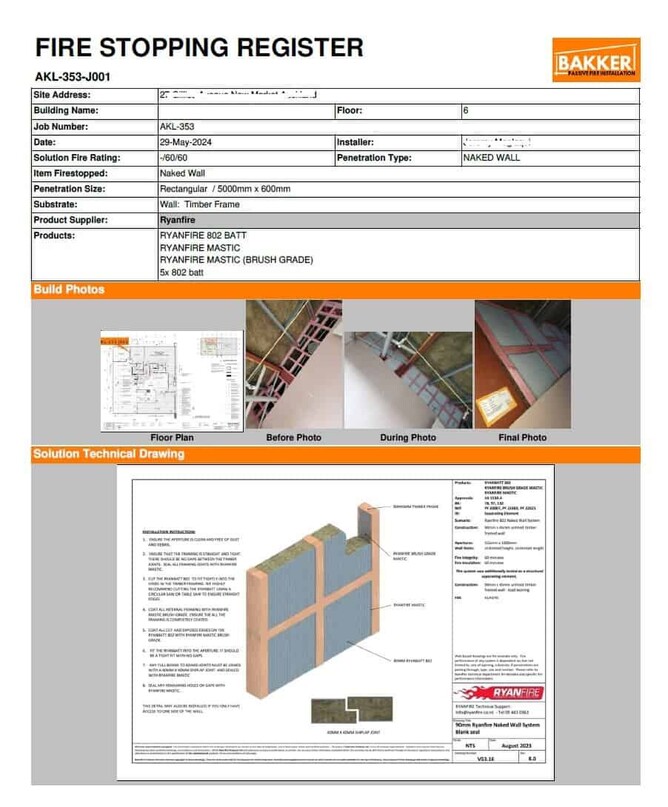At Bakker PFI, we’ve been at the forefront of developing Passive Fire Registers, and they’re far more than just paperwork—they’re a key part of keeping buildings safe and compliant.
The Passive Fire Register is a comprehensive record of all fire-rated installations in your building.
It documents everything from fire-resistant walls to firestopping materials, ensuring that all passive fire systems are tracked and properly maintained.
Why It Matters
Compliance
Building codes and fire safety regulations, like the New Zealand Building Code Clause C3.4 require stringent fire safety measures.
A Passive Fire Register is your proof that every installation meets these standards.
It’s essential for passing fire inspections and staying compliant with local laws.
Accountability & Transparency
A detailed register ensures that every fire-rated installation is accounted for, holding contractors, installers, and building owners responsible for their role in maintaining safety.
At Bakker PFI, we’ve made it our mission to ensure all passive fire installations are accurately documented, from fire-rated doors to walls and firestopping materials.
Simplified Maintenance & Inspections
With a Passive Fire Register, you don’t need to guess where your fire-rated systems are located.
Whether it’s during regular inspections or maintenance checks, having every fire-rated product logged makes the process far more efficient.
Compliance with NZBC C3.4, which mandates routine fire system maintenance, is also easier with a well-maintained register.
Reduced Risk & Cost Savings
By ensuring that certified fire protection products are documented and well-maintained, you reduce the risk of fire spread.
What Does It Include?
The Passive Fire Register tracks every fire-rated element in your building, including:
Fire-rated walls, doors, and ceilings: These barriers are designed to contain fire within one compartment, giving occupants more time to evacuate.
Firestopping materials: These seal gaps around pipes, cables, and ducts to prevent fire from spreading through these penetrations.
Intumescent coatings: Applied to structural elements, these coatings expand when exposed to heat, protecting the building’s structural integrity and preventing collapse.
Fire dampers and ventilation systems: These prevent fire from spreading through ductwork, automatically closing in the event of a fire to block flames.
Compartmentation details: This shows how your building is divided into fire-resistant zones, keeping fire contained to one area and preventing it from moving freely throughout the structure.
Penetration records: Every hole made in fire-rated barriers—whether for wiring, plumbing, or ventilation—needs to be properly sealed, and the register records the location and solution used.
Product certification and fire ratings: You can see all fire-rated products are certified to meet national and international safety standards.
Photographic evidence: Installations are often accompanied by before, during, and after photos, ensuring everything is properly documented and visible.
Having all of this information in one place ensures your building is not just compliant but well-protected and makes inspections and future maintenance much easier.
It’s about creating a system that’s transparent and manageable while protecting lives.
Who Needs a Passive Fire Register?
A Passive Fire Register is essential for several key players in building management and safety:
Building Owners and Facility Managers: You’re responsible for ensuring the building is compliant with fire safety regulations and can demonstrate that all fire-rated systems are properly installed and maintained.
Contractors and Installers: This register is your record of what’s been installed, where, and how it meets safety standards—ensuring your work is documented and up to code.
Fire Inspectors and Insurance Companies: They need clear documentation to verify that the building meets fire safety regulations, minimizing risk and potential liability. Having a well-maintained register simplifies their inspections and risk assessments.
In short, if you're responsible for the safety and compliance of a building, a Passive Fire Register is an absolute must.
It’s a safeguard not just for the building but for everyone inside it.
How It’s Created
Creating a Passive Fire Register is a step-by-step process that ensures your building’s fire safety measures are thoroughly documented:
Installation: Certified contractors install fire-rated systems like walls, doors, and firestopping materials in the building.
Documentation: Every installation is logged in the register with details like fire ratings, the location of each element, and the type of materials used. This process often includes photographic evidence before, during, and after installation to ensure everything is properly installed.
Ongoing Updates: As new installations are added or old systems are maintained, the register is continuously updated. It’s not a one-time document—it evolves as the building’s fire safety systems are upgraded or modified. This ensures that you always have an up-to-date record of your building’s fire protection status.
By following this process, the register becomes a critical tool for ensuring safety and compliance in the long term, keeping your building ready for inspections and, most importantly, prepared in the event of a fire.
Why Use Certified Products?
Certified passive fire protection products, like those from Ryanfire, Hilti, or Protecta are essential.
They meet strict fire safety standards and ensure your building’s fire safety systems will perform when it counts.
Non-certified products can fail during a fire, which is why we only work with tested and proven materials.
Working with certified products also ensures compliance with NFPA and AS1851 regulations, providing peace of mind and lowering liability.
Ben’s Wrap
The Passive Fire Register is a crucial part of your building’s fire safety strategy. It’s not just about ticking boxes for compliance—it’s about protecting lives, assets, and your business.
At Bakker PFI, we’ve been trusted leaders in passive fire protection for years, and we’re here to help you implement and maintain a robust Passive Fire Register that keeps your building safe and compliant.
If your building doesn’t have a Passive Fire Register or it hasn’t been updated recently, now is the time to take action.
Let’s work together to ensure your building is ready for any fire safety challenge.

